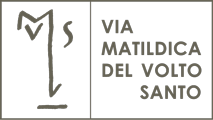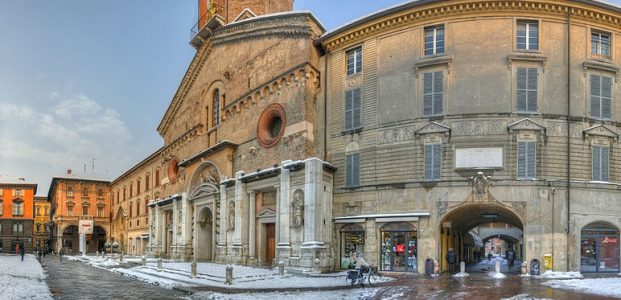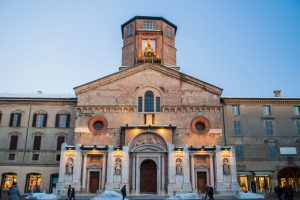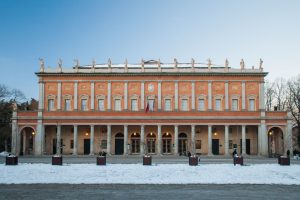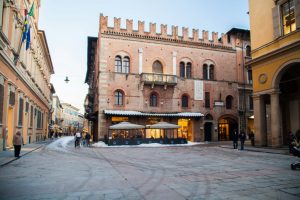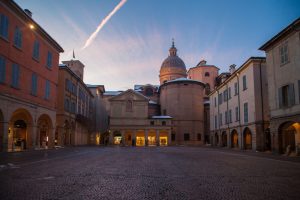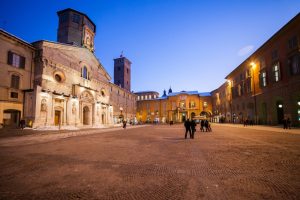It’s time to leave behind the small capital of the Gonzaga family’s duchy of Guastalla and head towards Reggio Emilia, the city where the Tricolore (i.e. the famous red, white and green of the Italian flag) was born. Following the direction of the Crostolo stream through cultivated fields until you eventually spot the new Mediopadana Station, designed by architect Calatrava.
- Departure from: Guastalla
- Arrive at: Reggio Emilia
- Distance: 31.7 kilometers
- Approximate journey time: 9 h
- Ascent:160 meter
- Descent: 121 meters
- Download leg route in gpx format
- Map in pdf format to print
Leg description
From Guastalla, continue south following the embankment of the Crostolo stream, passing the village of Santa Vittoria in the direction of Bagnolo in Piano, whose centre you can reach by leaving the embankment and taking the dirt road of Via Fornaci.
Between Ponte Forca and Via Fornaci, you can also avoid travelling along the embankment of Canalazzo Tassone, which is always exposed to the sun, by taking the gravel road that runs parallel, called Via Casaletto.
You’ll first reach Pieve Rossa and then Bagnolo.
From here, take the narrow Via Pioppa on the southern edge of the town, which ventures into the countryside as far as the outskirts of the city of Reggio Emilia, where you will first encounter the new Mediopadana Station designed by Santiago Calatrava.
Taking the underpass, you’ll pass by the railway and motorway to head in the direction of the city stadium area. The city centre can be reached either on foot following the road signs or by city bus.
Useful information
Rest areas (water and food): the route crosses the plains of Reggio Emilia where you can easily find places to stock up on supplies. The route, in fact, passes through the localities of Santa Vittoria, Pieve Rossa and Bagnolo.
The longest stretch without any amenities nearby is between Santa Vittoria and Pieve Rossa, a 10-km stretch along an embankment with little opportunity for shelter from the heat or rain. It’s a good idea during the hot seasons to stock up on water in Santa Vittoria. However, halfway between Santa Vittoria and Pieve Rossa, in the Villa Seta area, there are agritourism establishments and restaurants that can be reached in the event of an emergency.
Access to public transport: easy access to public transport along the entire route. There are several public transport stops (to and from Reggio Emilia) in the towns of Santa Vittoria and Bagnolo. Just outside Reggio you will find the Mediopadana high-speed railway station, which offers numerous direct daily connections to major Italian cities such as Milan, Bologna, Florence, Rome and Naples. In the centre of Reggio, you’ll find the local station for regional and interregional lines that also lead to the Riviera. Adjacent to the central station is also the arrival and departure point (Piazzale Europa) of all the outer-city transport lines in the province, including those connecting with stops along the Via Matildica such as Vezzano sul Crostolo, Casina, Carpineti, Toano, and Civago.
Pharmacies: Santa Vittoria, Bagnolo in Piano and, of course, in Reggio Emilia.
Where stay
In the spring of 2022, the “welcome and hospitality” of the parish of San Pellegrino opened, just a few steps from the Via Matildica route. Details.
Reggio Emilia, the arrival point of the stage, offers many accommodation facilities of all levels, even for large groups. From starred hotels, to the thoughtful welcome of small B&Bs, from farmhouses on the outskirts of the city, to the city hostel.
In this page you can consult all the solutions with addresses and contacts.
If you want you can also book directly some structures on Booking.com
What to visit
In Reggio Emilia:
- The Basilica of Ghiara
- Duomo
- Basilica of San Prospero
- Civic Museums
- Hall of the Tricolore
- The Theaters
- All other points of interest
Along the way:
- Collezione Salsapariglia in Pieve Rossa
- Mediopadana station
